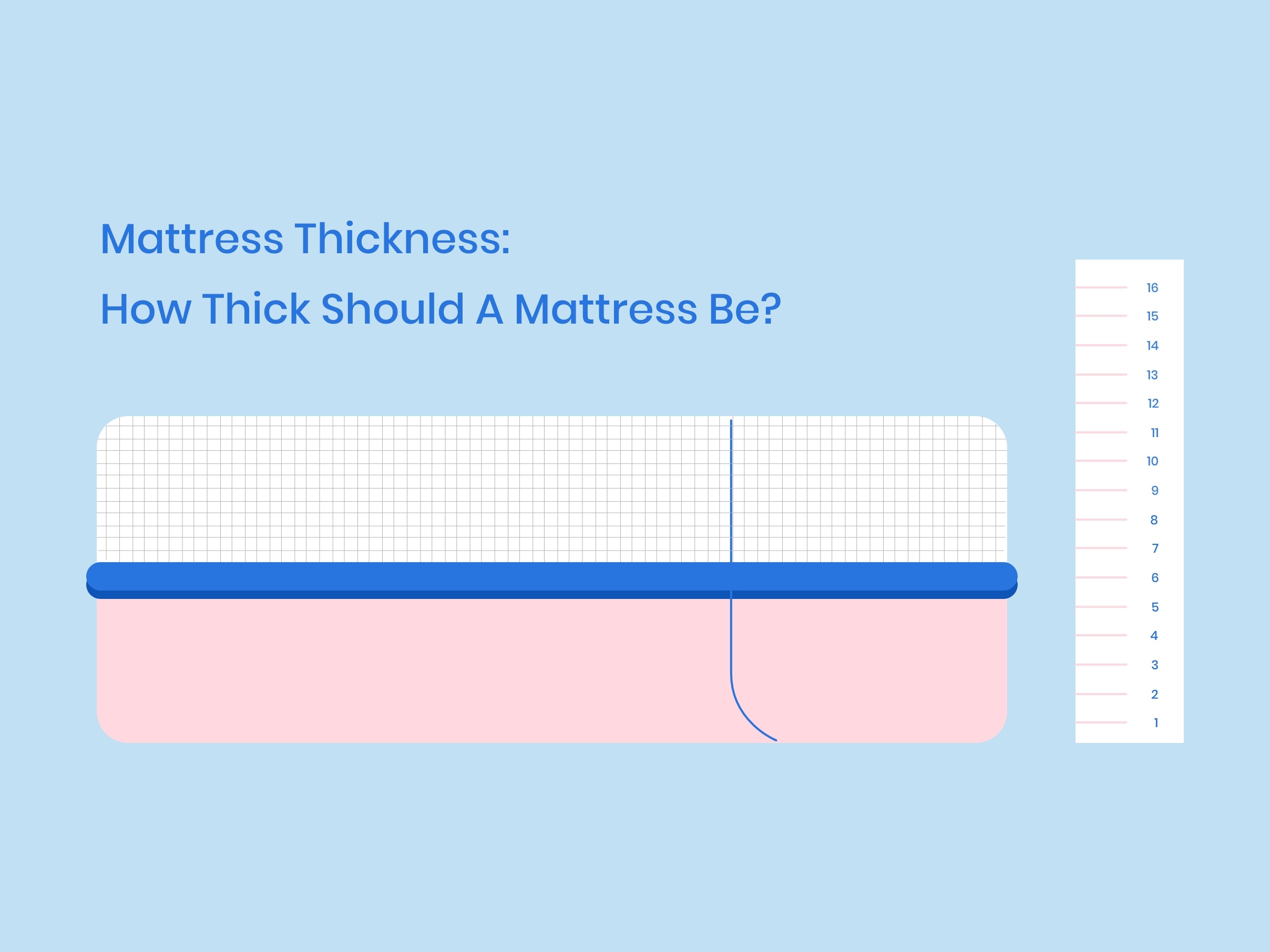Mattresses
Published February 8, 2022
10 minMattress Thickness: How Thick Should a Mattress Be?
It’s essential to consider mattress thickness while buying a mattress. Why? Because a thick mattress is comfortable, luxurious, and perfect for a good quality sleep every night, while a thin mattress

Table of contents
Mattress Thickness ChartFactors that Influence the mattress thickness Mattress Types Vs ThicknessHow to Choose the Right Mattress ThicknessBenefits of Thick MattressDrawbacks of Thick MattressFrequently Asked Questions
It’s essential to consider mattress thickness while buying a mattress. Why? Because a thick mattress is comfortable, luxurious, and perfect for a good quality sleep every night, while a thin mattress can strain your back, break down quickly, and provide poor-quality sleep. And, we don’t want that, do we?Mattresses thicker than 16 inches are known as extra deep or extra tall mattresses. It’s recommended that the top of your mattress is 25 inches from the floor, so your feet can easily reach the floor when you are sitting on the edge of the bed. This mattress thickness guide will cover how thick a mattress should be, the ideal mattress thickness, the difference between low profile and slim mattress, mattress thickness levels, and mattress firmness .
Mattress Thickness Chart
There is no thumb rule for standard mattress thickness. Every individual has different tastes. However, that being said, the average thickness of high-quality mattresses usually ranges from 8 to 14 inches.| Thickness | Mattress |
|---|---|
| 2 to 5 Inches | Low Profile |
| 5 to 8 Inches | Slim Profile |
| 8 to 12 Inches | Standard Profile |
| 12 to 16 Inches | Deep, Thick, or Tall Profile |
| More than 16 Inches | Extra Deep, Extra Thick, or Extra Tall Profile |
Factors that Influence the mattress thickness
The layers inside the mattress aid their thickness. While most mattresses have about a 2-inch layer inside, they can differ when it comes to high-quality mattresses. It can have three, four, and more layers. Each layer offers something different to ensure complete comfort, such as durability, support, and plushness.Comfort Layer
The comfort layer is always the top layer because that directly affects your comfort. Usually, the comfort layer is made of pillow-to, poly-foam, or wool layer. And when it comes to mattresses, such as latex, hybrid, or foam, they have latex or memory foam as their top-most layer. The comfort layers can be about 2-3 inches thick. This not only gives you a cushiony feel but also offers optimal support. Below the comfort layers are the transition layers. Some brands also offer customization of these layers.Base Layer
The base layer is responsible for the mattress durability. The base layer usually makes about 50% of the mattress thickness.Mattress thickness Breakdown
Here is the list of different thickness of bed and their uses.Low Profile (2-5 inches)
If you have a toddler or guests who come occasionally, you should get a low-profile mattress. These mattresses are perfect for infants and you can also use them as folding beds for guests. You can also find air mattresses of 2 to 5 inches in the market. You should not invest in a low-profile bed for everyday use unless it’s for a toddler or a murphy bed. Daily use of a 2-5 inches bed can be uncomfortable.Slim (5 to 8 inches)
Slim mattresses are thin but slightly thicker than low-profile mattresses. They have a few extra inches to make them suitable for daily use. These are great for kids, as they are lightweight and don’t require enough support. You can also consider this bed if you are short or have limited mobility. It is thick enough to sleep comfortably on.Standard (8 to 12 inches)
Standard mattresses have average mattress thickness. Their thickness of mattress suits most of the adults and sleeping positions. The best thing is that they provide a variety in materials, price, and technologies.Tall, Deep, or Thick (12 to 20 inches)
These beds are soft, durable, and an excellent fit for the side and plus-size sleepers. It’s a wide range and you can easily find these mattresses in the market.Extra Thick, Extra Deep, or Extra Tall (20 inches or more)
Extra thick, extra deep, or extra tall mattresses are usually more soft and durable. If you are considering expensive and extra-large options, you can go for mattresses that are 20 inches or more.Mattress Types Vs Thickness
Let’s now take a look at the most popular types of mattresses and their thickness.Memory foam
Memory foam mattresses can be anywhere between 8-14 inches. This is optimal to conform to your body and adjust to your body shape. Here, the thumb rule is simple: opt for a thicker mattress if you want more support.Hybrid
Hybrid mattress brings you the best of a foam mattress and an innerspring, so you enjoy a deep slumber. The ideal thickness of a hybrid mattress is anywhere between 3-4 inches in the comfort layer and 7-8 inches in the base layer.Latex
A latex mattress is made of all-natural material between 6-13 inches. These mattresses are also eco-friendly and highly durable, where they can last more than 15 years.Innerspring
An innerspring mattress is the most traditional style of mattress, which has support coils in the base layer. The thickness of an innerspring mattress is about 7 inches.How to Choose the Right Mattress Thickness
Now that you are well acquainted with the thickness of a mattress, let’s move on to how you can choose the right mattress thickness.Mattress depth depends on your size, sleeping position, and various other factors. For daily use, you should use at least an 8-inch mattress.Sleeping Position
Your sleeping position plays a significant role while determining mattress thickness. So, let’s understand the average thickness you must choose as per your sleep style. They include;- Back sleepers: Between 6 and 8 inches. This is to provide support to your shoulders and spine.
- Side sleepers: Between 8 and 10 inches. This is because you need proper support for your shoulders and hips.
- Stomach sleepers: At least 10 and 15 inches. Here, you require comfort and support for their fronts and lower back.
- Combination sleepers: 12-inch thick mattresses because you need beds that balance firmness and softness.
Body Type
The next factor you must consider is the body type.Lightweight
Thin mattresses can be too firm for petite or light sleepers. You should use at least a 12-inch mattress to get a comfortable nighttime experience.Average Weight
An average-sized adult sleeper must have a 10 to 12-inch mattress for adequate support. You can have a thicker or thinner mattress depending on their sleeping position.Plus Size
A plus-sized sleeper should use at least a 12 to 14-inch thick mattress. This would ensure that the bed lasts longer.Sleeping Partner
Single adults put less pressure on the bed so that they won’t need thick mattresses. However, if you share the bed with someone, you need a thicker mattress. A mattress should have a thickness of at least 10 to 12 inches for two people. If you and your partner are heavy, you should go for a 12 to 14-inch mattress.Health and Medical Conditions
Depending on your health condition, you may require a thicker or thinner bed to ease the pain or any other issues you may have. If you suffer from fibromyalgia, shoulder or hip pain, or arthritis, go for a thicker mattress (12 to 14 inches). For back pain, go for thinner mattresses (10 to 12 inches) to prevent sinkage and sleep comfortably.Height of Your Bed Base
Finally, it is imperative that you consider the depth of a mattress. For instance, if your bed frame is on the taller side and you are short, a thin mattress would work and if your bed frame is low, you can always opt for something thicker. So, consider the mattress height based on the height of your bed frame.Benefits of Thick Mattress
Some of the benefits of a thick mattress include;- They are more durable as the supportive base is usually thicker than 6 inches.
- Thick mattresses offer you the necessary plushness.
- A thick mattress feels very opulent and cozy.
- These are good for side sleepers due to extra cushioning.
- Thick mattresses are strong enough for couples or plus-size sleepers.
Drawbacks of Thick Mattress
Now, moving on to some of the drawbacks of a thick mattress.- These are costlier than thin mattresses because of the extra cushion it offers.
- These are difficult to move as they are heavy.
- They may trap heat due to extra cushioning.
- They can be very tall and difficult to access if you are short or petite.











